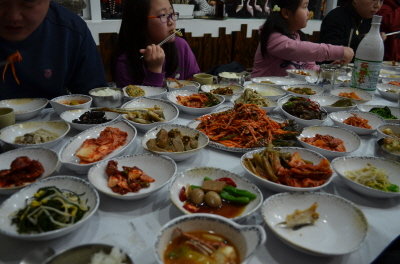The Korean food table is made up of ‘rice,’ ‘soup,’ and ‘small-dishes.’ Many people say ‘side dish’ in English but ‘small dish.’ ‘Small dish’ is the right expression. Every dish can be developed into one excellent food. For example, Koreans, who are known to be Korea’s representative food, ‘Galbi Chim (Beef Short Rib Stew,’ ‘Bulgogi (Barbeque Beef),’ and ‘Japchae’ are enjoying a small dishes with rice.

Just like Tapas in Spain, all the Tapas menus are good main dishes, so Korean small dish is also a good dish, so it is right to call as a ‘small dish.’
These small dishes are also from the sky, from the sea, and from the earth, so it is no exaggeration to say that the whole universe is on the table. It is also a very balanced healthy diet that is not devoted to one nutrient.
Banchan is a term that is collectively known to be side dishes in Korean stable. The B sound lies somewhere close to the English B and P: You once in a while observe the word composed as “panchan.” Banchan is used both in the form nature and plural nature- – one banchan, two banchan. Soup and rice are not considered banchan, but rather everything else, as long as they are displayed in little plates to be shared by the table, is amusement.
Banchan that as often as possible show up on local Korean eatery tables comprises of kimchi (aged/salted vegetables with bean stew pepper), namul (cooked vegetables prepared with sesame oil, garlic, and soy sauce), and jorim (vegetables and/or proteins stewed in juices).
Numerous Korean banchan depend on fermentation for flavor and protection, bringing about a salty, tangy, and hot taste. However, as we specified prior, essentially anything but rice and soup can be banchan. In Korean homes, you regularly experience things like salted laver (nori ocean growth) perfumed with sesame oil, and entire garlic heads protected in soy sauce, and additionally oak seed jam, and stewed eggplant when they are in their pinnacle seasons. Even dishes that can stand their ground as primary dishes, for example, pajun (delicious hotcakes with green onions) and japchae (mix signed Korean glass noodles with vegetables and meat), change into banchan when they make their nearness in little dishes to be imparted to the entire table.
The easiest way to enjoy and the most delicious small dishes are ‘wild vegetables.’ In Korea, you can find ‘wile vegetables’ easily at the Korean grocery stores and market. And more, over 70% of the land is made up of mountains and hills. On Korean mountains, new sprouts spring up from early spring (from mid-February) until the autume, and these herbs are boiled and dried in the sunlight and enjoyed throughout the whole season even in the winter months. Since there are more than 1000 kinds of these herbs, Korean mountains give great food to humans just as a free of charge. If you want to come to Korea and enjoy various wild plants, you can find a temples food restaurant or a vegetarian restaurant. Many temples in the past have settled down in the mountains and used to serve meals instead of donation for visitors. There are not many, but a few temple food restaurants and vegetarian restaurants in the city center, so you can enjoy a variety of wild plants while you were staying in Korea.
